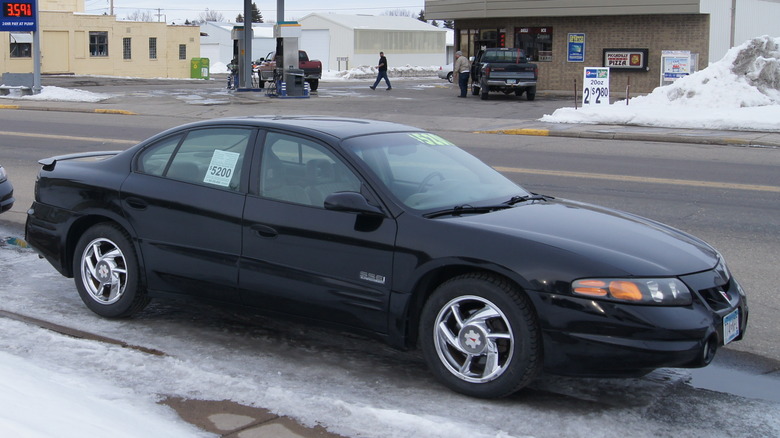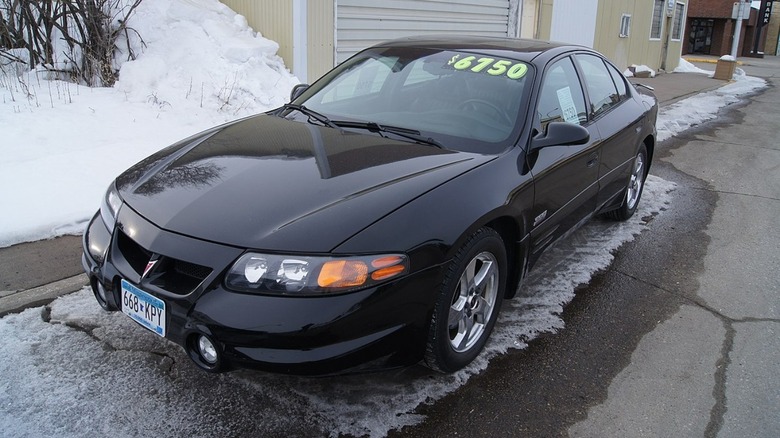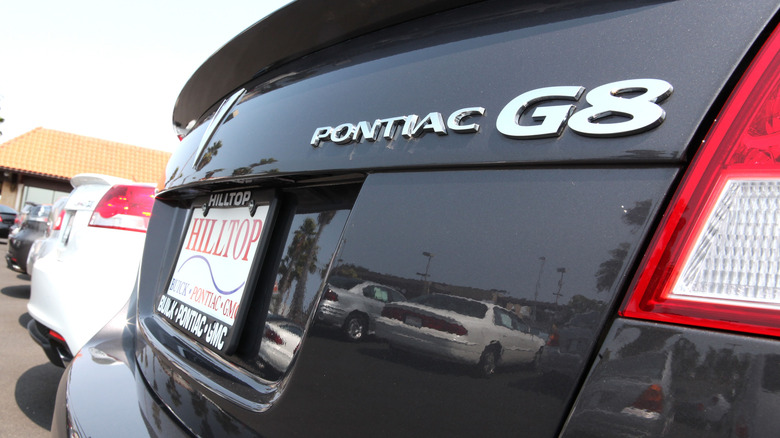What Engine Did The Pontiac Bonneville SSEi Use And How Powerful Was It?
Pontiac's Bonneville SSEi was, in many ways, the ultimate edition of the sedan. The wider model had already existed for some 40 years (launching as its own car in 1958) when the SSEi edition was released, and as an extra letter in a vehicle's name often denotes, it was intended as another step beyond the SSE.
The Bonneville SSE itself arrived in the late 1980s, a model that slotted in next to the LE and SE editions that had previously defined the nameplate. It wasn't long before the SSE had utterly set itself apart: 1992's Bonneville lineup, for instance, offered an SE edition with 220 lb-ft of torque and 170 horsepower, packing a 3.8 liter V6 engine. The SSE was equipped with a supercharger that pushed those values to 205 horsepower and 260 lb-ft of torque, matched by the SSEi edition in the year that it was added to the family.
Over the rather long life of the SSEi and the wider model family itself, though, it's not as simple a matter as saying that the "i" edition just used a more powerful version of the base model's engine. We've already provided an in-depth rundown of the SSEi for Pontiac fans, but now let's take a look at the engine options the SSEi employed over its lifetime. Just how powerful was it, and what was the powertrain equipped in the model that finally outdid it?
[Featured image by via Wikimedia Commons | Cropped and scaled | CC BY 2.0]
Early years of the Bonneville SSEi's engine
The SSEi model, as we've seen, was introduced to the Bonneville family for its '92 line-up. This edition was equipped with a 3.8-liter V6 engine, the same specs as the rest of its family, though the SSEi had a secret weapon: a supercharger from Eaton. Armed with this, the model's Buick 3800 engine could achieve 205 horsepower, as well as a top speed of approximately 131 mph, and could hit 60 mph from a standstill in just under nine seconds, on top of 260 ft-lb of torque.
The SSEi would develop quite quickly from this point. It retained these same base specs for the following model year, but two years after its introduction, the '94 SSEi's Roots Eaton Supercharger had pushed it even further, to a top speed of approximately 142 mph and another bump to 225 horsepower and torque of 275 ft-lb. It retained these capabilities again for '95, before the 1996 model year wielded the Series II Ecotech 3800. It represented another new level for the model, eking out a further 15 horses and offering a new top speed of 145 mph. By this point in its lifespan, this premium Bonneville hit a hefty torque of 280 ft-lb. The eleventh generation of the Bonneville ended with the '99 model year. Its engine still had more to offer for the final years of its life, however.
[Image by Greg Gjerdingen via Wikimedia Commons | Resized and cropped| CC BY-SA 2.0]
The SSEi Bonneville SSEi's engine: The later years
In March 1999, Car and Driver was given the unique opportunity to take the SSEi of the newly-redesigned Bonneville line-up for a test drive. The publication noted that, though the SSEi model was equipped with the V6 it had long been, this was no longer the very same engine. "The venerable 3.8-liter V-6," it concluded, "has undergone some fairly extensive changes, including a new harmonic balancer, power-steering pump, alternator, transmission-oil pump, and induction and air-cleaner system."
The '2000 SSEi had certainly taken the "new millennium, new me" approach so many of us did almost a quarter of a century ago. This model year, it was equipped with a GM Ecotec V6, and its specs stood at that formidable 240 horsepower and 280 ft-lb of torque. The Bonneville lacking these supercharged specs, by contrast, was good for approximately 210 horsepower and 230 lb-ft torque.
As the Bonneville family has amply proven up to this point, the "same" engine can be retained for years in a vehicle, as long as it continues to be tweaked, tuned, and amended along the way. The '03 SSEi — the last model year — continued to boast that 3800 Series II. The V6 engine had served the Bonnevilles well, and as the 1993 commercial above states, was intended to compete with other heavyweights without the hefty price tag. The SSEi's successors, however, would be equipped with a rather different type of powertrain.
How did the Pontiac Bonneville SSEi stand up to its rivals?
There's no denying that the SSEi model tended to be top of the class when it came to Bonneville specs on paper. As is the natural order of things, though, it would be overtaken and replaced in time by another Pontiac. The wider Bonneville family would ultimately meet the sad fate of discontinuation in 2005, but this was only after ten fascinating generations of the model.
The last Pontiac ever made was a different model that went on quite an odyssey, but the SSEi gave way to an even more formidable machine: The rather short-lived Pontiac G8, a model of which is pictured here, which debuted in 2007. In 2009, Pontiac closed its no-longer-profitable doors, but not before the G8 family had proven its power. The '09 G8 GXP offered 415 horsepower and 415 lb-ft of torque, powered by a 6.2 liter V8 that made it: Motor Trend concluded in a first drive of the model that it was "the best-performing, most well-balanced production Pontiac ever."
It was, to an extent, a culmination of everything the brand had achieved with the Bonneville. Its most potent variant, the SSEi, was the stepping stone that led to it.


